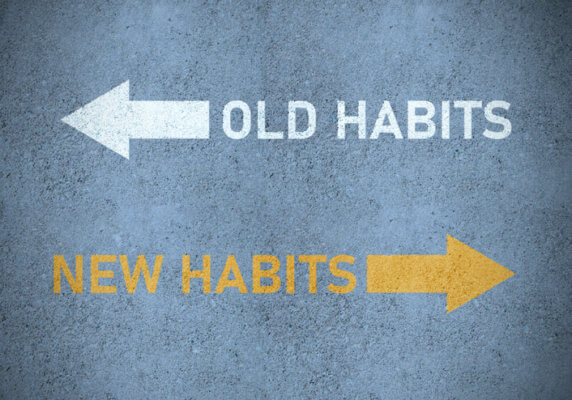 SPECIAL GUEST BLOG BY KARA MOHR
SPECIAL GUEST BLOG BY KARA MOHR
There are many things you can do to support forming new habits, but perhaps the one that is most important, is creating an environment for success.
- If you want to walk outside, it helps to have a walkable area that is safe and convenient.
- If you want to upgrade your snacking habits, it helps to only have nutritious choices available.
- If you want to find more peace and calm in your day, it helps to create time and space for yourself.
I think we can all understand how these things help at a surface level. However, it wasn’t until I was taken out of my normal routine that I realized just how important a role our environment plays.
In mid-December, my 83-year-old mother broke her femur while walking down her stairs. As she rehabbed at home, my family decided someone needed to be with her 24/7, so we divided up the calendar.
When my time came to be my mom’s roommate for an extended amount of time, I decided I would simply maintain as much of my normal eating and workout routine as possible – just at her house. I planned a menu and packed a cooler with my favorite groceries. As I grabbed three different sized kettlebells and loaded them in the car, I thought, “This is going to be so easy to stick with.”
Except, old habits die hard.
My mom is known as the “baker lady.” It’s a nickname she’s earned by baking all her life and sharing these baked goods with everyone in her community. One year at Christmas, she made 125 dozen cookies (yes, that’s 1,500 cookies) and delivered them to the area shut-ins. There is always an abundance of goodies at her house, but what happens when the woman who cares for everyone else needs to be cared for? That’s what I call sugar-on-sugar. There were daily deliveries of homemade food, cookies, and chocolates. Oh, and fudge. And, more cookies.
It doesn’t matter how tried-and-true your habits are, if you are in an environment that is counter to what you normally live in, you’ll have a harder time making those choices. Plus, if you find yourself in an environment that previously shaped other habits, those old (even very old) habits can become the go-to, without even noticing.
Think of your brain’s neural network like a series of trails. The more formed and practiced a behavior is, the more likely you are to make that choice – like hiking a well-traveled path to get to where you want fast. However, old neural pathways don’t disappear. They still exist, but because you stopped making that choice, the path, metaphorically, becomes covered over with weeds. In other words, once that groomed trail has become an overgrown jungle, then when your brain is faced with a choice, thanks to the environment, it realizes that the quickest path to that “old” choice is right there – ready for the taking – and you might find yourself making those old choices more easily than you care to.
And hence, why I found myself struggling to keep up with my eating and exercise habits. There were sweets everywhere: like, everywhere and in every room – from the kitchen that you must walk through to enter and leave the house, to the adjacent dining room, and on the table between the chairs in the living room. The weather was cold and gray; it felt selfish to prioritize my own well-being while I was there over hers, etc.
What happened to “This will be so easy?”
The key is to work WITH whatever environment you’ve been given. If you find yourself in an environment that isn’t supporting the behaviors you want to choose, consider using these 3 tips.
- Remove the Unwanted Choices from the Environment.
This tip is the most direct and the easiest one to support new habits, but it doesn’t always work in shared environments. I couldn’t just throw these food-related gifts in the garbage. Besides the fact that my mom is from a generation who believes you don’t waste food, it was her house and these were her gifts. However, if you can remove the unwanted choices, this is the first step to make it easier to support the choice you want to make. Consider this, not only in the things you stock your home with, but also for occasions when you’re traveling, or you’re picking a restaurant, etc.
- Minimize the Unwanted Choice.
Think “out of sight, out of mind.” Everyone in my family would put all the goodies in “the cabinet.” Let me tell you, years of living with my mom taught me that if I opened THAT cabinet, I would always find a sugar jackpot of deliciousness. That cabinet had to be addressed.
I moved the items from that cabinet and started curating. What can be labeled and frozen for later? What can be stored in the pantry for months? What can we give to others? Pretty soon, I was able to change the environment from one that had food and sweets everywhere to one that contained the sweets in hard-to-reach, closed cabinets. This reduced the number of times our minds had to make a decision about “Should I eat that or not?” But then, I went a step further. Instead of putting remaining sweets back in the cabinet, I moved things around and stored the Tupperware and storage containers in there instead. Trust me when I say, no one was more surprised than me whenever I would find myself bored, opening the cabinet to look for a little somethin’ sweet, only to have neatly organized glass storage containers and lids staring back at me. If they could talk, those storage containers would certainly have been snickering each time I fell for the same thing. “Oh Hello, Old Friend. Good to see old habits are still here.”
Other ways to minimize unwanted choices include putting them in places you don’t normally choose to go to, or open. You can also put these items in opaque containers so you can’t see what’s inside.
- Make Desired Choices More Available.
The last thing to do is to up the real estate of the desired choices: think location, location, location. Put a bowl of fresh fruit on the counter. Make sure chopped and prepped veggies are front and center in the fridge. Keep the choices you want to make in your sightline and somewhere that is accessible and inviting. A client used to keep her treadmill in the corner of her basement, but hated using it because it was uninspiring. Moving the treadmill to the first-floor guest bedroom meant having a window with a view and a TV for entertainment. How can you make the things you want to use more available and more inspiring?
In the end, the 11 days I got to spend as my mom’s roommate were wonderful. I was reminded of such a necessary component of well-being: relationships. And how time with loved ones (whether you’re in a routine or not) can be a great boost to your overall well-being. Plus, I had the chance to really see the positive impacts of my daily well-being practices and how they support me (or don’t, when ignored).
It’s not enough to have a practice, you have to create an environment and system that enables that practice to happen.
 About the Author
About the Author
Kara is a Signature Leaders faculty member.
Kara Mohr, PhD, FACSM is an internationally recognized dynamic keynote speaker who is known for her expertise and experience in the areas of mindset, resilience, strategies for physical, emotional, and mental well-being and behavior change. For more than 25 years, Kara has been using her warm and engaging style to inspire teams and individuals to transform their understanding of personal energy and well-being.
Kara is co-founder of Mohr Results, Inc., a well-being company that focuses on well-being content creation and facilitation to help people & organizations create healthy, thriving cultures that value well-being, relationships, the human experience, and performance.
Head to Mohr Results to see more about Kara.
